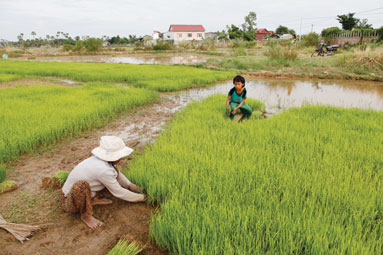

Villagers harvest rice in Siem Reap province late last year. Cambodia hopes to meet an export goal of one million tonnes per year by 2015. Photo by: Will Baxter
ACHIEVING Cambodia’s goal of exporting one million tonnes of rice per year by 2015 will require investments of US$350 million over the next four years, according to a Ministry of Economy and Finance official.
“Cambodia currently has the capacity to produce 200,000 tonnes of rice for export, because we lack capital and high-standard rice mills,” said Ministry Secretary of State Hang Chuon Naron
yesterday.
Speaking on the sidelines of a conference on “Environment, Agriculture and Development”, he said that it would take $150 million to build high quality rice mills, and another $200 million to buy unprocessed rice from farmers, to meet the 2015 goal.
The Government was working with commercial banks on easing financing restrictions, aiming to increase loans for rice traders and mill owners, Hang Chuon Naron said in his conference speech.
Minister of Agriculture, Forestry and Fisheries Chan Sarun said increased focus on the agricultural sector meant it was expected to grow further in the years ahead.
Cambodia’s total rice harvest is expected to hit 8.25 million tonnes this year, with supply exceeding demand by 3.9 million tonnes, he said.
Last month, the United Nations Food and Agricultural Organisation revised upwards projected 2010 rice production in Cambodia to 8 million tonnes, noting much of the surplus ends up as unofficial cross-border exports to neighbouring countries.
Cambodia Centre for Study and Development in Agriculture President Yang Saing Koma said that the availability of financing and high interest rates were the largest hurdle towards meeting the 2015 rice export target.
“This is a problem,” he said. “We need a lot of money.”
A majority of Cambodians depend on the sector for a living, making rice farming important for economic growth but also for employment in rural areas, he said, adding that the goal of one million tonnes’ exports by 2015 was achievable. Increased lending ought to come from several sources, including commercial banks, state-owned Rural Development Bank, the Government, and development partners, he said.
“The problem is money, as well as the interest rate. It’s still relatively high compared to Vietnam and other countries,” he said.
ACLEDA Bank President In Channy said commercial banks in Cambodia had increased their loans to the agricultural sector significantly over the past year.
“Commercial banks may cooperate with an increase in credit to the sector,” he said.
ACLEDA Bank accounted for some 58 percent of overall lending to the agriculture, forestry and fishery sector in 2009, the latest year for which National Bank of Cambodia statistics are available.
Last month, the World Bank and the Government launched a programme to improve access to loans by agri-business by guaranteeing 50 percent of loans to the sector by participating commercial banks. ADDITIONAL REPORTING BY JEREMY MULLINS
Contact PhnomPenh Post for full article
Post Media Co LtdThe Elements Condominium, Level 7
Hun Sen Boulevard
Phum Tuol Roka III
Sangkat Chak Angre Krom, Khan Meanchey
12353 Phnom Penh
Cambodia
Telegram: 092 555 741
Email: [email protected]








